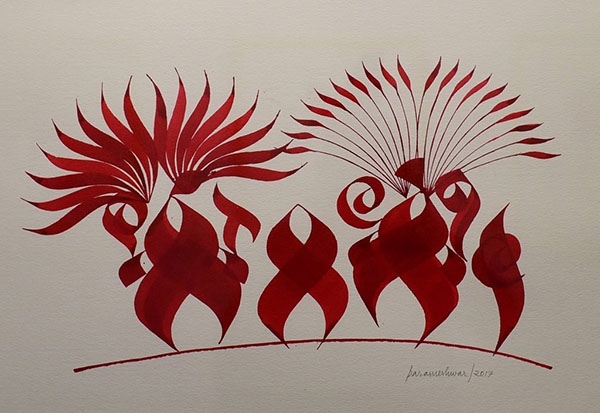Parmeshwar Raju’s Art Simple strokes, complex stories
Artist Parmeshwar Raju’s art uses the written word to create something extraordinarily beautiful.
The afternoon rays light up the small studio cum apartment of Artist Parmeshwar Raju as he settles down for a chat, while his blank notebook lies open next to him. If one were to describe his art in the most simplest of terms, it would be calligraphic art.
A quick look at his paintings gives the impression of art heavily inspired by the mythological epics and temples. And the artist agrees that to be the case, his inspiration comes from traditional narratives. “You will see lot of influence of sthal puranas (story of the temples). How it originated, the gods, what the people were like, their beliefs, the mystical aspects etc. Some of these things one can’t even begin to comprehend like the fact since many people worship there, it becomes a place of energy and gradually turns pious due to that very energy,” says Parmeshwar who decided to transform these stories through a new art form.
“I learnt the art of writing inspired from the scriptures and prayers. I wanted to see if I could add some elements to make it more exciting. I didn’t want to use a different tool to make an illustration or portrait, so I shifted from calligraphy to pictorial calligraphy,” adds Parmeshwar Raju who studied applied art at Government School of Art in Aurangabad.
His ‘out of box’ style of painting sprung to life during breaks while working on designs as a student. “Earlier we didn’t have computer so we had to do the designs manually. The ideation used to take a long time, which meant creating the design left us with little time, so the entire task of ideating, creating and finishing would up taking us 8-10 hours. In the breaks, I would sit and practice for few minutes,” says Parmeshwar, adding, “the idea was to create pictorial elements with the same tool and build upon it.”
Instead of the conventional brushes, he uses English poster calligraphy nibs in built with right slant for Devanagiri strokes. “One basic stroke you will see in my all works is thin, thick and thin…a beginning and an end. I use a parallel nib with two plates stuck together used for writing and drawing so I can draw a thick and thin line simultaneously. For bigger works, I use brass nibs,” says the self-learnt artist. Since a lot of his work is trial and error, finishing a bigger work takes a long time. The Ramayana series itself took him seven years where he got stuck for two years trying to figure out how to create Hanuman’s silhouette. “That’s the longest time I have taken on a series. I did the boat first and ended with Shiva narrating the story of Ram to Parvati which is actually the first bit in the story but it ended up being the last painting,” shares Parmeshwar.
His paintings are fairly complex achieved by the clever use of red juxtaposed with a white backdrop where the spaces add to the intensity. “I mostly use red, black, red oxide, blues, green and browns. But there is a lot of red in my work, even though it’s quite difficult to work with red. Till a certain limit, it looks perfectly balanced, beyond that it looks faded. If you add little more, the red becomes vulgar and difficult to control. During design practice, we would use red colour to make logos to see whether it’s balanced. It is also very pleasing to the eye to a certain level. So in my works, the mundane is represented by white,” explains Parmeshwar. His Ashtavinayaka, Buddha series, with varying shades of reds is reminiscent of this rule where the use of dip nibs creates a textured effect of dark and light strokes.
The style of art being symbolic and abstract often leads to some interesting reactions wherever his work has been exhibited in cities such as Delhi, Calcutta, Mumbai, Chennai, Kochi, Dubai, Brussels, Amsterdam, USA, and Germany. “Many people have tried doing similar art after looking at my works and calligraphers have tried to replicate it, but it’s not that simple,” says Parmeshwar, smiling.
“There is a misconception that art is unique to a few set of people, it’s not. It’s about creating something others can see and enjoy otherwise it doesn’t have any meaning. That’s why everything was so beautifully done in ancient times in traditional culture. The craftsman took such great pains to create the form. Some of the best art comes from small villages because the artist is contented and is happy doing what he does,” feels Parmeshwar who has just finished researching the rituals of Jagannath Temple in Puri.
 Parmeshwar Raju’s Art Simple strokes, complex stories
Parmeshwar Raju’s Art Simple strokes, complex storiesSource: telanganatoday.com



